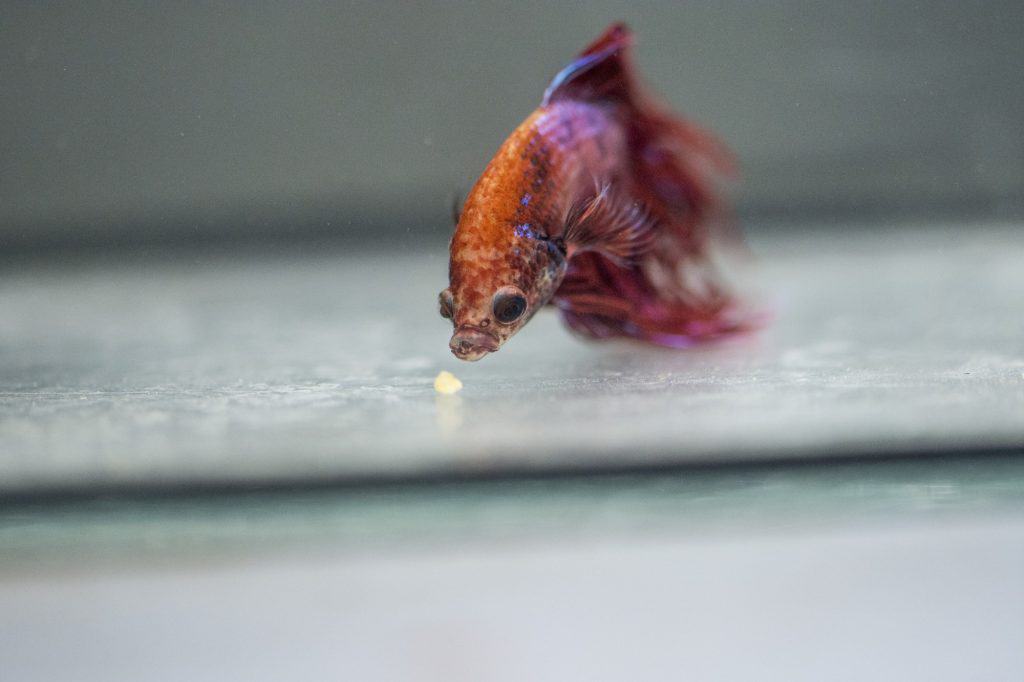Osmotic shock in fish is a condition caused by abrupt changes in the osmolarity of their external environment. Osmolarity is the concentration of dissolved substances, such as salt and sugar, inside a solution. When this concentration changes suddenly due to an influx or outflow of water, it can cause osmotic stress on fish.
This can occur naturally when there are sudden shifts in salinity levels between freshwater bodies or during floods and storms that release large amounts of rainwater into oceans and lakes. It can also occur when people add too much salt or other chemicals to aquariums for cleaning purposes. Symptoms include gasping at the surface of water, listlessness and immobility, swollen gills, abdominal bloating and discoloration (black spots).
Treatment involves restoring balance in the water system by slowly introducing new salt concentrations until they match those found in natural environments.
Osmotic shock is a serious issue for fish, as it can cause dehydration and death. When the water surrounding a fish’s body contains less salt than its internal fluids, osmotic shock occurs as water enters the body through the skin or gills to try to balance out the salt levels. This sudden influx of water into their system causes swelling of tissues, disruption of normal metabolic processes, and in some cases death.
To prevent this from occurring, it’s important that aquarium owners take steps to keep their tanks with consistent salinity levels.

Credit: bettasource.com
How Can You Tell If a Fish is in Shock?
If you think your fish is in shock, there are certain signs that you can look for. These include a decrease in activity, erratic swimming behavior, loss of color and an overall unhealthy appearance. Furthermore, if the fish appears to be gasping at the surface or lying on its side rather than moving around normally then this is another sign of possible shock.
In addition to these physical symptoms, your fish may also display other signs such as increased aggression towards tank mates or hiding more often than normal due to anxiety caused by the stress it has experienced. If any of these behaviors are observed then it’s important to take action immediately by testing water parameters and providing extra oxygen if necessary. Additionally, maintain cleanliness and remove any uneaten food from the tank so that bacteria does not have a chance to accumulate which could further exacerbate your fish’s health issues.
Can Fish Survive Water Shock?
Yes, fish can survive water shock. Water shock is a sudden change in the temperature or pH of water in an aquarium, which can be caused by adding too much of certain chemicals when cleaning tanks, changing filters and pumps, or doing major maintenance on equipment. It usually results in stress-related diseases such as ichthyophthirius (white spot disease) and bacterial gill infections.
The best way to prevent water shock is to make any changes gradually over several days so that the fish have time to adjust before experiencing drastic environmental changes. Fish are resilient creatures, but they still need time to adapt to new conditions before experiencing a full-fledged water shock event. Fortunately, most healthy fish will bounce back from a milder water shock if proper steps are taken quickly—like reducing tank temperature or chemical concentrations slowly and removing any dead or dying fish immediately—and their environment is monitored closely for further signs of distress after the initial incident has passed.
Why Do Fish Go into Shock After Water Change?
Fish go into shock after a water change because of the drastic differences in chemical composition between their previous environment and the new one. When fish are taken from their natural habitat, they become accustomed to these specific chemical levels. Therefore, when a large or sudden water change is made to their tank, it can cause major stress for them due to the significant difference in pH balance and other factors such as temperature and oxygen levels.
A sudden shift in any of these parameters can prove fatal for fish if not handled properly. To minimize this risk, it is important to ensure that you acclimate your fish gradually by slowly adjusting the temperature and other elements of your aquarium before introducing them into the new environment. This will help reduce stress on your aquatic friends while also increasing their chances of survival during a water change!
What Happens to Fish in Osmosis?
Fish, like other animals and plants, are affected by osmosis. Osmosis is a process that occurs when water passes through a semi-permeable membrane from an area of high concentration to an area of low concentration. In the case of fish, this means that if the water in their environment becomes too salty (high salt concentrations), freshwater will pass into the fish’s cells and tissues to dilute it; conversely, if there is not enough salt in their environment (low salt concentrations), then sea water will pass out of their cells and tissues to increase its salinity.
This can lead to dehydration or even death for some species of fish as they become unable to maintain the proper balance between salts and liquids inside them. To help prevent this from happening, many aquarium owners use special products such as reverse osmosis filters or chemical additives that remove excess salts from their tanks so that the amount of sodium chloride remains below lethal levels.
PH Shock | Osmotic Shock | Protect your fish
How to Treat Osmotic Shock in Fish
Osmotic shock occurs when fish are exposed to drastic changes in their environment, such as a sudden change in salinity or pH. To treat osmotic shock in fish, you should first try to reduce the stress on the fish by moving them into an area of stable water quality. You can also add aquarium salt at a rate of 1 teaspoon per 5 gallons of water to restore electrolyte balance and help with osmoregulation. Lastly, make sure that any new additions to your tank are properly acclimated over time so that your fish don’t experience further shock from changes in temperature or chemistry levels.
How to Save Dying Fish After Water Change
If you notice your fish struggling to survive after a water change, there are some steps that you can take to help them recover. First, increase the oxygen level in the tank by adding an air stone or bubbler. Second, check for any signs of disease and treat accordingly with aquarium-safe medications.
Finally, reduce stress on the fish by providing plenty of hiding places in the aquarium and making sure not to overcrowd it. By following these tips, you should be able to save dying fish after a water change.
Fish in Shock Symptoms
Fish that are in shock can exhibit a variety of symptoms, including lethargy, loss of appetite, decreased activity level, clamped fins and pale gills. If your fish is in shock it should be removed from the tank immediately and placed into clean water with the same temperature as its original environment to help it recover. Additionally, you may need to treat your fish for any underlying causes such as parasites or bacterial infections.
Fish in Shock from Cold Water
Fish in shock from cold water is a serious condition that can be fatal if left untreated. Fish are unable to regulate their body temperature, and when exposed to colder temperatures than they are used to, the sudden change causes physiological stress. Symptoms of fish shock include gasping at the surface of the water, listlessness or disorientation, as well as a loss of appetite and color changes.
To help prevent this issue, it is best practice for anglers to keep their catch in aerated buckets mixed with pond or tank water until ready for release back into its natural habitat.
Fish in Shock After Water Change
It is common knowledge that fish are very sensitive creatures and can easily be affected by changes in their environment. Recently, a group of aquarium enthusiasts experienced this firsthand when they changed the water in their tanks and the fish went into shock. After making sure all parameters were correct for the new tank conditions, it was discovered that the drastic change caused an imbalance in ammonia levels.
This sudden increase put stress on the fish’s immune system, causing them to become sluggish and weak – a condition known as “fish shock”.
Can Fish Recover from Osmotic Shock
Yes, fish can recover from osmotic shock. Osmotic shock occurs when sudden changes in salinity and temperature cause a rapid shift in the water’s osmotic pressure. This imbalance can be fatal to some species of fish, but many are able to make a full recovery by gradually acclimatizing themselves to their new environment over time.
To help aid the recovery process, it is important for aquarists to monitor their tank conditions closely and adjust levels as needed in order to prevent future episodes of osmotic shock.
How Long Do Fish Stay in Shock
Fish can stay in shock for a few hours or even days depending on the severity of the situation. The most important factor is to ensure that the water temperature, oxygen levels and pH are all within an acceptable range as soon as possible. If these conditions cannot be met quickly, it is likely that the fish will remain in shock until they die.
Additionally, if stress factors such as handling or overcrowding continue, it is likely that the fish will not recover from their state of shock and may die from exhaustion or other complications.
Fish in Shock Or Dead
Fish can go into shock when exposed to sudden changes in their environment, such as temperature, pH levels or salinity. This can cause the fish to become unresponsive and eventually die if not treated promptly. Signs of shock include erratic swimming patterns, listlessness and a lack of coordination.
If your fish appears to be in shock, you should immediately place them in an isolation tank with clean water that is at the same temperature as their original environment. Additionally, oxygenation should be increased and medications may need to be administered depending on the severity of the situation.
Conclusion
In conclusion, osmotic shock in fish is a serious matter that must not be overlooked. With proper monitoring of the water parameters, as well as regular acclimation processes when introducing new fish to an aquarium environment, this issue can be avoided and allow our aquatic friends to thrive in their new homes. Additionally, it’s important to know that continued exposure to osmotic shock can cause permanent damage or even death for your fish.
It’s up to us aquarists to ensure we are taking all necessary steps towards providing a safe and healthy home for our finned companions.
